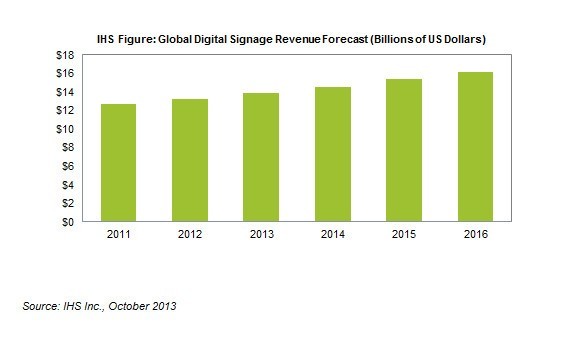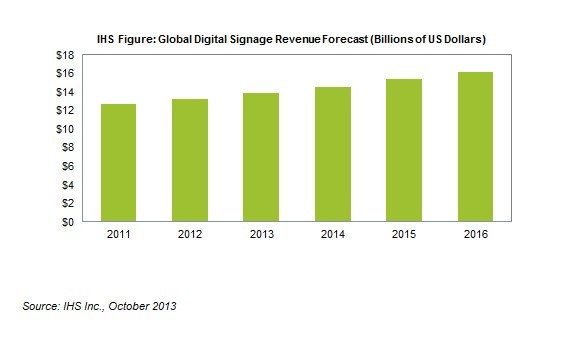
Leading Authority You’ve Never Heard Of Pegs Digital Signage Market at $14 Billion
October 31, 2013 by Dave Haynes

A Denver-area research company that seems to have its collective eyes on everything under the sun – including photovoltaic cells this week – has issued its take on the prospects for the digital signage sector.
I greet analyses by “experts” from research firms that are experts on everything with considerable ambivalence. But if you have investors or other people who need to see stabs at the macro-economics of this space, and encouraging growth charts, here goes …
IHS Inc. says the global digital signage market will grow to nearly $14 billion by year-end “with the addition of data-centric information and analytics driving up revenue.”
Worldwide revenue for digital signage equipment, software, services and media is projected to hit $13.9 billion at the close of 2013, up a solid 5.6 percent from $13.2 billion last year. This year’s growth improves on the 3.9 percent expansion of 2012, and the next few years will see a continued steady increase in revenue ranging from 4.7 to 5.6 percent. By 2017, total digital signage takings will amount to $17.1 billion, as shown in the attached figure.
The report was developed by Sanju Khatri, who describes herself on LinkedIn as one of this industry’s “leading authorities.” Maybe it’s just me, but shouldn’t a leading authority on the space have the teensiest bit of name recognition in said space?
“Improvements in technology offerings, data management and infrastructure expansion will help the digital signage industry to continue the positive momentum it has already generated,” said Sanju Khatri, director for signage and public information displays at IHS. “And as digital signage becomes increasingly intelligent with smart content and dynamic interfaces, the integration of real-time data management into real-world applications will further stimulate revenue growth.”
In particular, the integration of real-time data and predictive analytics into digital signage is making a big splash among retailers, which are using digital signage solutions to target customers more efficiently, leading to increased dwell time, improved shopping experiences and a rise in sales.
Many fast-food restaurants—also known as Quick Service Restaurants (QSR) in the industry—are employing digital signage, for instance, to replace static signs with digital menu boards. The boards promote better customer engagement than static signs, while offering dynamic content and appealing visuals. Moreover, digital menu boards provide companies an opportunity to sell smarter by promoting new items, upselling higher-margin products and reducing inventory by making immediate changes to content for promotions or advertising, Khatri noted.
Characterized by fast-food cuisine and minimal table service, QSRs have also begun to utilize displays for point-of-sale (POS) data integration, with North America and Western Europe as the primary regions demonstrating this expansion. Live data feeds allow managers to conduct automated interactions that review real-time sales data and make adjustments locally to manipulate in-store marketing messages to affect the customer’s purchasing decisions and ultimately benefit sales figures, according to Kelly Lum, digital signage analyst for IHS.
Other applications employing live data feeds include corporations using digital signage networks throughout their organizations to improve efficiency in the workplace, increase the company’s bottom line, promote brand awareness and unity, display performance indicators and allow for easier connectivity across large organizations.
Digital signage has likewise become increasingly prevalent throughout many universities to show upcoming event details, as well as display building directories, way-finding maps and emergency messages to increase student and faculty safety.
Big pile of sweeping generalities anyone could crank by reading a couple of blogs and a few case studies. But to be fair I have not seen the full report, if there is one. Usually these press releases are bait to buy the very expensive full report, but don’t see any evidence of that here.
Very curious. The report doesn’t say what all adds up to that $14 billion number, and I’m not sure it’s one that’s all that meaningful to anyone except in that slide that lotsa people like to show in presentations that suggests this is a big, booming market.
The slides rarely also mention the sector is overcrowded and confused and populated by a lot of companies that are just scratching by.



Leave a comment